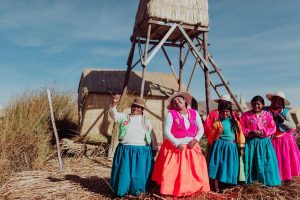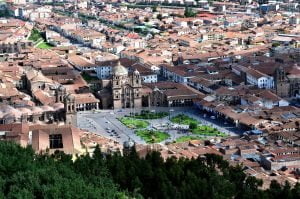Sadly the trip has come to an end all too soon. Transfer to Cusco airport, the bus station, or spend some more time exploring the incredible surrounds of the Sacred Valley. (B)
Choquequirao: The Secret Trail to Machu Picchu
9 Days 4945 ex Cusco

Accommodation
5 Nights Camping
3 Nights Hotel

Transportation
Mostly by foot.
Train & vehicle transfers

Included Meals
8 Breakfasts
6 Lunches
5 Dinners

Trip Grade
Category 3
High Heart Rate Holiday

Group Size
2 – 12 Trekkers
A momentary pause as you suck in the air. Panting, hands on hips.
At over 4000 metres, even little things, normally simple things, can be a challenge.
The stone beneath your booted feet is cold and hard, yet despite this, incredibly, it is worn smooth by the generations of generations that once trod this same path as you.
Barefooted, then crude sandals… now here you are in modern, fitted hiking boots.
Yet, despite all this, the stunning view before you, is the same as they would have had hundreds, even thousands of years past.
“Remote, spectacular, and still not entirely cleared, the ruins of Choquequirao are often described as a mini–Machu Picchu.
This breathtaking site at the junction of three rivers currently requires a challenging two-day hike each way“
Lonely Planet
Machu Picchu.
It features prominently in many people’s bucket lists, and with good reason. To see these incredible ruins, in person, is something else.
With time enough, most of these people who have it on their ‘list’ will eventually get to tick it off.
But for something so incredible, and for something that means so much to you, why not make it that little bit different to what everyone else does?
Why not walk the secret trail?
“In the variety of its charms and the power of its spell, I know of no other place in the world which can compare with it.”
Hiram Bingham, (re)Discoverer of Machu Picchu





The Journey
Welcome to Cusco! Arrive, collect your luggage and meet your guide, then it’s a short journey through this colourful South American city to our hotel.
Meet in the local Coffee Museum at 1pm to enjoy lunch and learn about the story and people behind this popular drink.
After lunch step out into the Cusco streets and explore with one of our carefully chosen guides.
They are not only very knowledgeable but also great fun to be with. You do not want to cram too much in on your first day at altitude, so relax and get used to being up high with a gentle walk around this old Inca capital.
Visit the Plaza de Armas, the Cathedral and the Qoricancha temple of the sun and perhaps take in the sights, sounds and smells of San Pedro food market too.
If you normally shop in supermarkets and farmers markets, you are in for a surprise. Stands full of juicy exotic fruits, counters heaving with cow heads and sheep hooves and cheerful local women selling handmade cheeses, local breads, healthy juices and even toad soup.
The evening is free to relax and wander around the UNESCO World Heritage Site city centre.
It’s an early rise, ready to depart Cusco around 5am and drive off to the stunning village of Cachora that towers above the Apurimac River and canyon.
Here we will meet up with our trekking team, munch on an early lunch then embark on a 1600m descent into the depths of the Apurimac canyon.
This is followed by a short climb with dazzling views of snow covered mountains, that is sure to take your mind off the ascent.
We will head down to Rosalina right on the shore of the Rio Apurimac. (B,L,D)
This morning we will cross the “Great Voice” (Apurimac) via a cable car.
Once across the river a steep incline ensues. Along the way we pass the tiny village of Santa Rosa and Maranpata (where we will have lunch).
A hard-hitting climb contradicted by the relief felt when setting up base not too far away from the astonishing remains of the ancient Inca town of Choquequirao (3100m). (B,L,D)
We’ll rise early for a days exploration of Choquequirao, a chance to marvvel at the historic remains, and absorb the scenery that rests 1700m above the Apurimac River (the whole space is larger than Machu Picchu).
In Choquequirao you will find exquisitely preserved architecture which sets the backdrop for its central plaza and its impressive terraces, jutting from the hillside.
A dense cloud forest populates the desolate city, creating the feeling that the town is being explored for the first time.
Depart Choquequirao for our base camp, to rest and recuperate for the following day. (B,L,D)
On the trail as dawn breaks, we’ll leave Choquequirao behind.
En route to Maizal, there will be a fleeting stopover at the remnants of a “water shrine” known as Picha Unuyoc.
This is a beautiful walk as we climb above Choquequirao, entering a new face of the mountain range, surrounded by high altitude forests.
From here we descend into the Rio Blanco canyon.
Be wary of the petulant, biting sand flies named the Pumahuacachi. According to the locals they “Make the puma cry”. Beyond, it is time for a final climb of around 1200m to the small campsite of Maizal, resting at an altitude of 3100m.
Prepare yourself, for today is the toughest section of the entire trip. (B,L,D)
Another early start as we clamber up to the pass of Abra San Juan.
At 4150m, Abra San Juan will take your breath away, as we marvel at the out-of-this-world view of the Cordillera Villacabamba Mountain range, especially the summit of Pumachau.
Here we’ll lunch to better appreciate the stunning view and if we are lucky a sighting of the impressive Andean Condor.
We will pass by the rundown silver mines of Mina Victoria that have been worked over for 1000 years.
Today’s trekking ends at the Andean community of Yanama.
The Yanama Valley is sublime in its beauty, with idyllic farming areas throughout and tumbling glaciers above.
From Yanama, we drive to Lucmabamba to overnight. (B,L,D)
This final day of trekking is along an historic Incan trail that winds to Llactapata, an ancient Inca site that has only been recently unearthed.
The path winds through flourishing fields of coffee plants, fruit plantations, as well as untouched cloud forests with enchanting views of Machu Picchu as we descend into the Urubamba valley.
Trekkers who still have some fuel left in their tanks can decide upon a further two – three hour hike to the lively tourist town of Machu Picchu Pueblo (commonly known as Aguas Calientes), or wait patiently for a train to take us to our destination.
This is an amazing train ride through some of the world’s most picturesque mountain landscapes, so if you take the ride, try and find yourself a good window seat!
At Machu Picchu Pueblo we’ll check into the hotel, revel in a hot shower before heading out to soak up the nightlife and sample the local cuisine. (B,L)
Another early morning to be ready to catch a bus or if you’re still feeling active a hike to the lost city of Machu Picchu.
There, we’ve a guided tour, with the option to climb Huayna Picchu (this is included in your expedition fee).
Get lost in the atmosphere of the deserted world of Machu Picchu and soak up the culture of the ancient Incan civilisation.
After a morning of exploration, we’ll board an afternoon train back to Cusco and our hotel, with the option to explore Cusco by night. (B)
Journey Extensions
Check out our Journey Extensions for those that want to stay a little longer or try something different along the way.
Arequipa, the beautiful “White City” and the nearby Colca Canyon is the perfect place to start or finish a trip to Peru and is ideal for both acclimatising to the rarefied air of the Andes, or for relaxing in its hot springs.
(4 Days/3 Nights)
Per person is $1200 (twin share)
Includes: 2 nights in Colca Canyon, 3 Star Hotel in Arequipa, English speaking guide, tours of Arequipa, Colca Canyon and Cruz del Condor, Entrance to Santa Catalina and Colca National Park, Silustani tour and entrance fees
Lake Titicaca offers a great way to relax and explore the fascinating culture of the Aymara Indians who dwell upom the lake. Take a boat cruise to the amazing floating islands of Uros and Taquile Island, overnight with a local family on Amantani or watch a sunset at the pre-Inca Ruins of Silustani.
(3 Days/2 Nights)
Per person is $1000 (twin share)
Includes: 3 Star Hotel in Puno, English speaking guide, Lake Titicaca tour, Luxury Train
A visit to our well appointed jungle lodge in the excellent lowland rain forest of the Tambopata National Reserve is one of the best ways to see some of the world’s best rain forest wildlife that is available in a short, economical stay.
The reserve and the adjacent Bahuaje-Sonene National Park, is home to over 20,000 plant species, over 900 species of birds (more species than in all of continental USA), 91 mammals, 1230 butterflies, 127 amphibians and reptiles, and much more. It’s a haven for the Amazon’s largest, most spectacular and most endangered predators – the Jaguar, the Giant Otter, the Harpy Eagle and the Black Caiman.
(4 Days/3 Nights)
Per person is $846 (twin share)
Includes: Two or Three nights full-board at Jungle lodge and full guided service throughout, All transfers to and from Puerto. Maldonado airport to Jungle lodge by bus, boat and canoe
Visit some of the delights in Cusco’s surrounds!
The famed Incan ruins of Tambo Machay (known as the Incan baths), Puca Pucara, Pisac and its delightful terraced slopes, Q’enko and the vast ruin above Cusco itself, Sacsayhuaman.
(Half Day)
Per person is $277 (down to $120 per person for a group of 4)
Includes: All entrance fees, English speaking guide, Transportation, Snacks & water

At 3,650 – 3,250m, this is also a perfect acclimatisation ride to prepare you for your onward travels at altitude.
(Half Day)
Per person is $162 (down to $66 per person for a group of 4)
Includes: English speaking guide, Transportation
Perched high atop the rugged walls of the Sacred Valley, this is one incredible experience.
Ascend via rope and harness, dine and sleep with the most impressive views.
When the experience is at an end, you can either climb back down, or ride a zipline!
With a pick-up and drop off from your Cusco hotel, they can accommodate the following pod configurations:
1 queen, 2 single beds or 4 single beds
Why not add a night to the beginning or end of your Incan adventure?
Contact us for pricing and availability.
Whether you need an extra night before your trek, or simply want to spend more time in this gorgeous city and its surrounds, Cusco is an incredible place in which to extend your adventure!
Contact us for pricing and availability.
Season
April through to October
Includes
- Arrival and departure transfers
- Cusco Walking Tour
- Vehicle connection to and from the trail
- Entrance into the Choquequirao and Machu Picchu Incan sites
- English and Spanish speaking guides trained in first-aid and C.P.R.
- 3 Star plus hotels in Cusco and Aguas Calientes
- All meals as indicated in itinerary (Breakfast – B, Lunch – L and Dinner – D)
- Sleeping bag, liner & pillow as well as trekking poles whilst on the trail
Excludes
- International Flights
- Connection to Cusco
- Travel Insurance
- Personal spending money
- Tips for General Guides
- Any meals not listed as included
Choquequirao
Resting high above the waters of Apurimac River, on the mountain of Salkantay, the city of Choquequirao the – Cradle of Gold -, lays in ruins. The remains of a once-great city spread out over 1,800 hectares, reached only by a two-day trek from the bustling city of Cusco, Choquequirao an ancient town that use to be inhabited by the lost race of the Incas. Privileged Incas were able to use the site as a place of worship, somewhere to honour the gods, aspects of nature and the river.
Erected under the rule of the Sapa Incas (Emperor) Tupac Inca Yupanqui and Huayna Capac, Choquequirao has been dubbed a – Sacred Sister – of Machu Picchu due to its resemblance seen in the elements of design and similar architecture. It was one of the last safe holds and refuges for the Incas from the Spanish invasion. Based on the hilltop, the city was provided with vast vantage points and could see enemy approaches on all sides.
The city was also likely to have been a checkpoint on the way to Vilcabamba and a link between the Amazon Jungle. It was theorized that Choquequirao, was a royal domain constructed for the Sapa Inca, Topa Inca to contend with his father.
In 1909, Hiram Bingham bought international light to the city even though Choquequirao has been mentioned since colonial times. The city attracted treasure hunters from all over, all curious to see what the tantalizing – the cradle of gold – offered. Many expeditions were led to the remains but treasure hunters left without any discoveries. Excavations began in 1970, and still, only 30-40% of the site has been excavated, most of the remains and history of Choquequirao, still shrouded with the surrounding jungle.
Protected by its remote location, the majority of the – cradle of gold – still remains unseen, its secrets just waiting to be discovered.
Your Guides and Safety
Your guide can make the difference between a good holiday and an exceptional holiday.
Efrain Valles (who has worked with us for over ten years), was even voted Wanderlust World Guide of the Year 2014!
All our guides come to us as recommendations from our current guides, and they are very careful who they recommend.
We consider training a vital investment to ensure the security and safety of all our trips. We also believe that trained guides are confident guides which help them to relax and enjoy the trip which we firmly believe will massively enhance your own personal enjoyment.
All our guides are qualified in first aid, with instructors brought in from the UK to run these courses.
On the ground, we have an extensive local contact network, which ensures that we are able to organize visits by the Doctors (when needed) and treatments as quickly and as comfortably as possible.
Accommodation
There’s no escaping it, this is a camping expedition, so for the most part, it’s going to be in a tent.
The plus side is, each and every morning, you’ll be waking in a new, stunning location!
“It’s an irritating reality that many places and events defy description. Angkor Wat and Machu Picchu, for instance, seem to demand silence… In the end, you’re just happy you were there – with your eyes open – and lived to see it.”
Anthony Bourdain
“Peruvian food is so simple yet amazingly flavored with their traditional spices.”
L’Wren Scott, Model & Designer
Food in Peru
Versions of most of the most common foods from home can be found, with hopefully something to suit even the fussiest of eaters (be they child or adult).
Furthermore, many Peruvian staples are now fairly commonplace in western grocers, especially the ubiquitous Quinoa.
For those wanting to be a little adventurous, we can rarely go past recommending Cuy (Guinea Pig).
Perhaps better known as household pets, in the Incan world, they have long been raised as a food source (you’ll even see evidence of this among the ruins as you explore).
Of course, if you’ve anyone with any dietary requirements, please reach out, as most can be accommodated.








